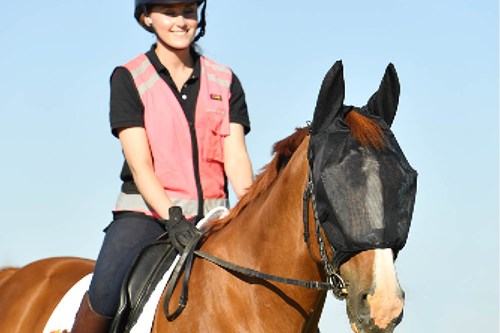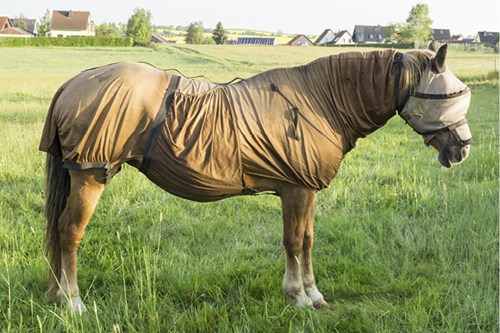Flies On Horses

The joy of long summer days and sunshine with our horses can be marred by the irritating problem of flies. Different species of these insects that, in the UK, include horse flies, midges, stable flies, house flies, blow flies and bot flies, can make their presence felt and each carry their own particular curse. At the least they are annoying, at their worst they can become a significant health threat. We investigate some of the best ways to alleviate their troublesome presence around our horses.

Fly masks (such as this one from Equilibrium Products) can be helpful to keep your horse comfortable in the field and out riding.
Stable fly (Stomoxys calcitrans) House fly (Musca domestica) and the Blow fly or Blue Bottle (Calliphoridae sp.)
The biting stable fly and the lapping house flies and blow flies are a general nuisance, attracted to dung, soiled bedding and other excretions. On the horse they gather around the mucus membranes and sweaty areas to feed off secretions , especially of the eyes, nose and sheath area. This can cause weepy eyes, head shaking and general irritation. They also target open wounds, which can delay healing, and carry bacteria with the potential to cause infection.
Discourage them by:
- Poo picking fields regularly, keeping stables and field shelters well skipped out, removing soiled bedding and siting the muck heap away from the field and stable area will take away the feeding and breeding ground for lots of flies and help to keep numbers down.
- Washing horses off after work and cleaning eyes, nose and dock areas regularly.
- Covering any open wounds with a dressing or barrier cream to discourage flies and prevent fly strike – when fly eggs are laid in wounds and hatch out into maggots.
- Applying a long-lasting fly repellent or using fly collars, leg bands or fly rugs impregnated with repellent.
- Consider using fly barriers such as anti-midge/fly turn-out rugs and neck covers, fringes, veils and nose nets.
- Putting up fly papers in the stable.
- Organising your horse’s management to help them avoid peak fly times.
Generally flies prefer still air; midges especially gather over water sources such as streams, troughs and puddles. If you can graze horses in a well-drained field that catches a breeze they’ll thank you for it. Turning horses out with company will enable them to stand nose to tail and swat flies away for each other.
> Do Horses Need Fly Masks?
We hear some of the benefits from Equilibrium Products
Horse Flies (Tabanidae sp.)
Horse flies feed on blood and can inflict nasty bites to horse – and human – to get their fill. These form large itchy, painful bumps with a central ulcer as the body reacts to them. No wonder horses can become agitated if they are about, often twitching, kicking at their bellies, swinging their heads to reach them on their shoulders and flicking their tail to try to dislodge them. All of which can be disconcerting behaviour, especially if you are trying to ride!
Horse flies or cleggs breed in woodland and are most prevalent near these areas. They’re only active in the day and prefer bright sunlight. Stabling horses during this time and turning out at night or providing a shelter where horses can take themselves into the shade will help to avoid contact with these menaces.
If that’s not possible then a thick enough fly rug will also act as a physical deterrent to avoid horses being bitten. An effective, long-lasting insect repellent is advised.

Above: full body rugs are often required to protect sweet-itch horses from midges
Midges (Culicoide)
Midges are tiny little flying insects that congregate to lay their eggs on standing water and amongst damp vegetation. The adult midges feed in swarms, especially at dawn and dusk, which can result in rashes of multiple tiny bite wounds.
More than simply an annoyance, some horses suffer badly with a condition called sweet itch, an allergic response to these bites. The wounds form itchy skin lesions that become aggravated further as the horse rubs them. A telltale sign of aggravation is a horse with a scrubbed mane and tail and they will often scratch until its raw. Sweet itch horses will need extra management such as stabling and comprehensive rugging to prevent them getting bitten.
Alternatively, if only the tail is rubbed then this could also be a sign of pinworm. An adhesive tape test can help to identify the cause.
Remove standing water where possible and in summer season try to avoid keeping horses in fields with ponds and streams. If midges are still a problem consider stabling at dawn and dusk when they’re most active.
Bot Flies (Gasterophilus spp.)
Bot flies, which look a bit like a scrawny wasp, rely on the horse to compete their lifecycle. During the summer months they can often be seen buzzing around their neck, chest, shoulders and legs looking for an opportunity to bomb in and lay their eggs on the horse’s coat.
Again fly repellents and rugs can be useful deterrents. Where you see the eggs laid on the horse’s coat scrape these off with a bot knife and look to treat for them in the winter after the first frost.
> More about Bots in horses
> Do Horses Need Fly Masks?
We hear some of the benefits from Equilibrium Products